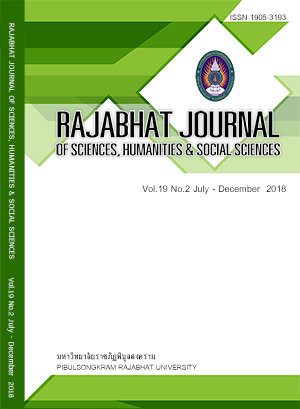THE STUDY OF THE PRODUCTION OF SATHON LEAVE TEA
Keywords:
Herbal tea, phenolic, sathonAbstract
This research aimed to study the suitable roasting time for producing tea from Sathon leave. The experiment was designed using complete randomized design. The young Sathon leaves aged 3-5 days were selected during February to March, cleaned and sliced into the length of 1 cm. The leaves were then roasted using the brass pan at 60°C for 10, 15 and 20 minutes. The samples were conducted to evaluate sensory characteristics, physical, chemical and microbiological qualities. It was found that tea roasted for 15 minutes provided the best sensory scores as evidenced by flavor and overall liking. The color values were found to be L* 28.72 ± 0.33 a* -0.38 ± 0.04 and b* 11.80 ± 0.96. The moisture content, pH and phenolic content were 5.67 ± 0.49%, 6.10 and 1.04 mg GEA/100 mL respectively. The Sathon tea kept for 45 days showed less yeast and mold counts than those specified by Thai Community Product Standards.
References
Chaiyamas V. Product development of herbal tea from Phak Wan Ban (Sauropus androgynus (Linn.) Merr.). Rajabhat Agriculture Journal. 2007; 6(2): 30-38.
Chidambara MK, Jayaprakasha GK, Singh RP. Studies on antioxidant activity of pomegranate (Punica granatum) Peel Extract Using in vivo Models. Journal of Agricultural Food Chemistry. 2002; 1450(17): 4791-4795.
Kaewruang W. Mullbery tea. Thailand: Printing Agriculture Cooperatives of Thailand, 1998.
Jamjang, K. Product development of tea with antioxidant from local plants in Kampheang Phet Province. Faculty of Science and Technology, Kampheang Phet Rajabhat University. Rajabhat Journal of Sciences, Humanities & Social Sciences. 2015; 16(1): 50-63.
Lee SW, Kang CS. Effects of Moisture Content and Drying Temperature on the Physicochemical Properties of Ostrich Jerky. US National Library of Medicine National Institutes of Health. 2003; 47(5): 330-343.
Nanthachai N, Monnamorn S. Effect of Processing on Antioxidant Activity and Total Phenolic Content of Pummelo Peel Tea. Agricultural Science Journal. 2013; 44(2): 221-224.
Office of Community Product Standards. Community Product Standards. Tea 120/2558, 2015.
Oppadissakul S. Statistics for Planning Experiments Elementary. Thailand. Kasetsart University, 1978.
Sahelian R. Polyhenols Supplement Research Study, Health Benefit, 2011. Available at: https://www.raysahelian.com. Accessed September 6, 2011.
Siwawej S, Jaisaard N. Extraction of Phenolic Compounds from Potato Peel. Proceedings of 41th Kasetsart University Annual Conference: Thailand. Kasetsart University, 2003.
Smitinand T. Thai Plant Names. Thailand. Thammasat University, 2001.
Sumran S. A Study of Nutritional Values of Phaksathorn Seasoning Sauce by Different Levels and Methods in Preparing Raw Materials. Thailand. Research. Loei Rajabhat University, 2007.
Thai Industrial Standards Institute. 2011. Local Product Standards. Available at: https://www.tisi.go.th/ contents/details/43/. Accessed January 21, 2012.
Downloads
Published
How to Cite
Issue
Section
License
Each article is copyrighted © by its author(s) and is published under license from the author(s).










